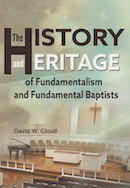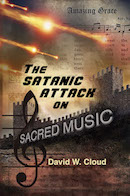866-295-4143, fbns@wayoflife.org
_________________
This is “an induced altered state of consciousness in which the subject becomes passive and is responsive to suggestion” (Harper’s Encyclopedia of Mystical and Paranormal Experience). The term hypnosis comes from hypnos, the Greek god of sleep, and was coined by James Braid, a 19th-century British mesmerist.
Hypnosis is used widely in medicine and psychology. Donald Connery, in Exploring Hypnosis, says, “There is greater interest in and employment of medical hypnosis than ever before in history.” The American Medical Association approved the use of hypnosis in 1958. Courses on hypnosis are taught in many medical schools and an estimated 20,000 medical and psychological specialists use it (“Hypnosis,” Encyclopedia of new Age Beliefs).
It is used in pain relief, anesthesiology, drug and alcohol abuse treatment, weight control, birth control, sleep therapy, physical healing, psychological healing, self improvement, human potential, regression therapy (healing the present through recovering the past), and many other ways.
When used in the field of modern health care, the idea is that the practice of hypnotism itself is innocent and useful and can be divorced from its occultic associations, but this is impossible. Hypnotism arose from occultism and remains intimately associated with occultism. The Encyclopedia of Occultism and Parapsychology says: “Hypnotism is no longer classed with the occult sciences. ... Nevertheless its history is inextricably interwoven with occultism, and even today much hypnotic phenomena is classed as ‘spiritualistic.’”
The history of hypnotism extends back to ancient pagan religions. The Encyclopedia of New Age Beliefs observes: “In various forms, hypnotism can be found in every culture in every age. Historically, it is typically associated with the occultist or psychic, the one who exercises power over things or persons, such as the shaman, magician, witch doctor, medium, witch, guru, or yogi.”
In the 18th century, Emanuel Swedenborg (1688-1772) communicated with spirits through a trance state induced by breath control. It was called somnambulance. In 1788, a Swedenborgian society in Stockholm reported to a sister society in France a number of cases in which somnambulists had transmitted messages from the spirit world (Slater Brown, The Heyday of Spiritualism).
Anton Mesmer (1734-1815), an astrologer and occultist, proposed a healing technique through hypnosis and the flow of “animal magnetism” from the practitioner to the patient. He held the occultic view that there are thousands of channels in our bodies through which an invisible life force flows and that illness is caused by blockages. The practitioner of animal magnetism could allegedly cure sicknesses by overcoming the obstacles and restoring the flow. The term “to mesmerize” is based on Mesmer’s hypnotic practices, and the field of modern hypnotism stemmed from his techniques.
Mesmerization or hypnosis produced two occultic movements in the 19th century.
One of these was the New Thought or Mind Science movement. Phineas Quimby (1802-66), a student of Mesmer, called his “mind healing” theories the Science of Health and had a deep influence on Mary Baker Eddy, the founder of Christian Science.
The other occultic movement produced by hypnotism was spiritism. Another Mesmer student, Andrew Jackson Davis, published a book in 1847 which he said was dictated to him by spirits while he was in a mesmeric trance. The Encyclopedia of Psychic Science says, “The conquest by spiritualism soon began and the leading Mesmerists were absorbed into the rank of the spiritualists.”
The spiritist revival in Brazil also began with hypnosis. French educator Leon-Denizarth-Hippolyte Rivail was led through hypnosis to communication with spirits. His spirit guide instructed him to take the name Allan Kardec, and under this name he wrote the very influential The Book of the Spirits (1857).
John Ankerberg observes: “Mesmerism, then, paved the way for occult revival. And there is an ominous parallel today in the great upsurge of interest in hypnotism as both an occult method and a medical-diagnostic tool. ... Whatever their differences, one fact is admitted by all. The phenomenon of mesmerism is today known as hypnotism” (The Encyclopedia of New Age Beliefs).
The danger of hypnotism is evident from the fact that it can produce a wide variety of occult phenomena, including past life experiences, multiple personalities, speaking in unknown languages, automatic writing, clairvoyance, telepathy, seizures, spirit possession, astral projection, and psychic diagnosis (“Hypnotism,” Encyclopedia of New Age Beliefs).
One famous example of multiple personalities that developed through hypnosis is Susan Houdelette. She was a normal woman who sought the help of a therapist to quit smoking, but when placed under hypnosis she developed 239 different personalities!
There is an entire field of repressed memory syndrome whereby supposed hidden memories are recovered through hypnosis and other techniques. What has often been recovered, though, are fantasies that are then seen by the patients as reality. “... there are thousands of victims today who, because of hypnotic regression, only think that they were subject to sexual or satanic abuse as children. This has resulted in great tragedies, including ruined families (where parents were the alleged abusers or Satanists) and patients who committed suicide. Because thousands of families have been torn apart by things like this, a national organization has been formed specifically to draw attention to the problem and to help victims of what is termed the ‘false memory syndrome’” (Encyclopedia of New Age Beliefs).
Many support hypnotic therapy because “it works,” but just because something works does not mean it is right. There are innate powers within man that can be manipulated and there are Satanic powers. The magicians in Egypt were able to perform amazing feats and could even duplicate some of the divine miracles (Exodus 7:10-12, 19-22; 8:5-7).
Further, it must be understood that hypnotic healing often results in “symptom substitution,” whereby victory in one area results in defeat in another. One woman who lost her fear of spiders developed a strong addiction to alcoholic. Another who found relief from gall-stone pain began to suffer from terrible outbursts of rage. Dr. Kurt Koch, a Christian expert in occultic phenomena, warned: “I could quote many examples like this involving so-called harmless hypnotists. ... The unfortunate thing is that occult hypnosis is often used as a means of obtaining healing. The apparent success of the hypnosis, however, is accompanied without fail with all sorts of mental and emotional disturbances” (Demonology Past and Present, 1973, p. 128).
Even though hypnotism has been “secularized” and brought into the fields of health care and education, it is still intimately associated with the occult.
It is one of the most prominent techniques in the New Ager’s toolbox. It is used as the door to astral planes, as the key to uncovering UFO abductions, and as a wonder tool to help people develop psychic powers. Simeon Edmunds, author of The Book of Hypnosis, says the first step to the development of psychic power is to enter the deepest possible level of hypnosis. In Hypnotism and the Supernormal, Edmunds says that “many of the most famous spiritualistic mediums began their psychic careers as hypnotic subjects, and hypnosis has been used with marked success in the development of a number of others.”
Hypnosis is used by channelers to prepare themselves for communication with spirits. For example, Esther Hicks, the channeler of Abraham, makes contact with her spirits through self-induced hypnotic trance. Further, various channeled spirits have actually recommended the practice of hypnosis.
Hypnosis is used to recover the events of alleged past lives. As a member of the Self-Realization Fellowship Society before I was converted to Jesus Christ, I was taught a method of hypnosis or guided imagery which was supposed to allow me to investigate my past lives. Some who have used this technique have actually seen places in their “imagination” that they have never before visited only to discover them later while traveling.
This is a fearful demonic deception, because the Bible says man lives once and then faces judgment (Heb. 9:27). If reincarnation is true, the Bible is a lie.
Yet hypnosis persistently results in past life recovery. One study of 6,000 hypnotized subjects found that 20% reported “earlier lives” (Deidre and Martin Bobgan, Hypnosis and the Christian, p. 23). And this is true even when it is used by therapists who don’t believe in reincarnation. For example, psychologist Diana Denholm first used hypnosis to help people stop smoking and lose weight and other such things, but when some of her patients experienced “past lives” she became convinced of its reality. She now uses regression therapy regularly (Raymond Moody, Coming Back: A Psychiatrist Explores Past-Life Journeys, pp. 12-13). Psychiatrist Brian Weiss, author of Many Lives, Many Masters, is another example. He became a believer in reincarnation when one of his female patients, while under hypnosis, described past lives.
The fact that hypnosis is so intimately associated with the occult and communication with spiritual realms forbidden in Scripture is a loud warning to those who have ears to hear (Leviticus 19:31; Deuteronomy 18:10-12). The wise Christian will stay far away from anything savoring of the occult! Playing with such things is like a child playing with fire.
The Bible exhorts the believer to be sober (1 Peter 5:8). To be sober means to be in control of one’s mind, to be spiritually and mentally alert. It means to be on guard against danger. It is the opposite of allowing oneself to be put into a trance or emptying one’s mind in “contemplative devotion.” The Bible warns that demons transform themselves into angels of light (2 Cor. 11:13-15). Unless the believer remains sober and vigilant, he is in danger of being deceived. Thus, even a “mild” level of hypnotism can be spiritually dangerous.
The fact that hypnosis is used today by Christian psychologists and doctors, does not justify it. We live in an apostate age of illicit ecumenism, syncretism, and interfaith dialogue, an age in which multitudes of professing Christians have turned their ears from the truth and have turned to fables (2 Timothy 4:3-4). Instead of standing on the Bible alone as the sole authority for faith and practice, professing Christians are delving into forbidden realms and mixing the truth together with lies. The white of truth and the black of error have been intermingled to become the gray of compromise.
- Receive these reports by email
- www.wayoflife.org
______________________
Sharing Policy: Much of our material is available for free, such as the hundreds of articles at the Way of Life web site. Other items we sell to help fund our expensive literature and foreign church planting ministries. Way of Life's content falls into two categories: sharable and non-sharable. Things that we encourage you to share include the audio sermons, O Timothy magazine, FBIS articles, and the free eVideos and free eBooks. You are welcome to make copies of these at your own expense and share them with friends and family. You may also post parts of reports and/or entire reports to websites, blogs, etc as long as you give proper credit (citation). A link to the original report is very much appreciated as the reports are frequently updated and/or expanded. Things we do not want copied and distributed are "Store" items like the Fundamental Baptist Digital Library, print editions of our books, electronic editions of the books that we sell, the videos that we sell, etc. The items have taken years to produce at enormous expense in time and money, and we use the income from sales to help fund the ministry. We trust that your Christian honesty will preserve the integrity of this policy. "For the scripture saith, Thou shalt not muzzle the ox that treadeth out the corn. And, The labourer is worthy of his reward" (1 Timothy 5:18). Questions? support@wayoflife.org
Goal:Distributed by Way of Life Literature Inc., the Fundamental Baptist Information Service is an e-mail posting for Bible-believing Christians. Established in 1974, Way of Life Literature is a fundamental Baptist preaching and publishing ministry based in Bethel Baptist Church, London, Ontario, of which Wilbert Unger is the founding Pastor. Brother Cloud lives in South Asia where he has been a church planting missionary since 1979. Our primary goal with the FBIS is to provide material to assist preachers in the edification and protection of the churches.
Offering: Offerings are welcome if you care to make one. If you have been helped and/or blessed by our material offerings can be mailed or made online with with Visa, Mastercard, Discover, or Paypal. For information see: www.wayoflife.org/about/makeanoffering.html.





